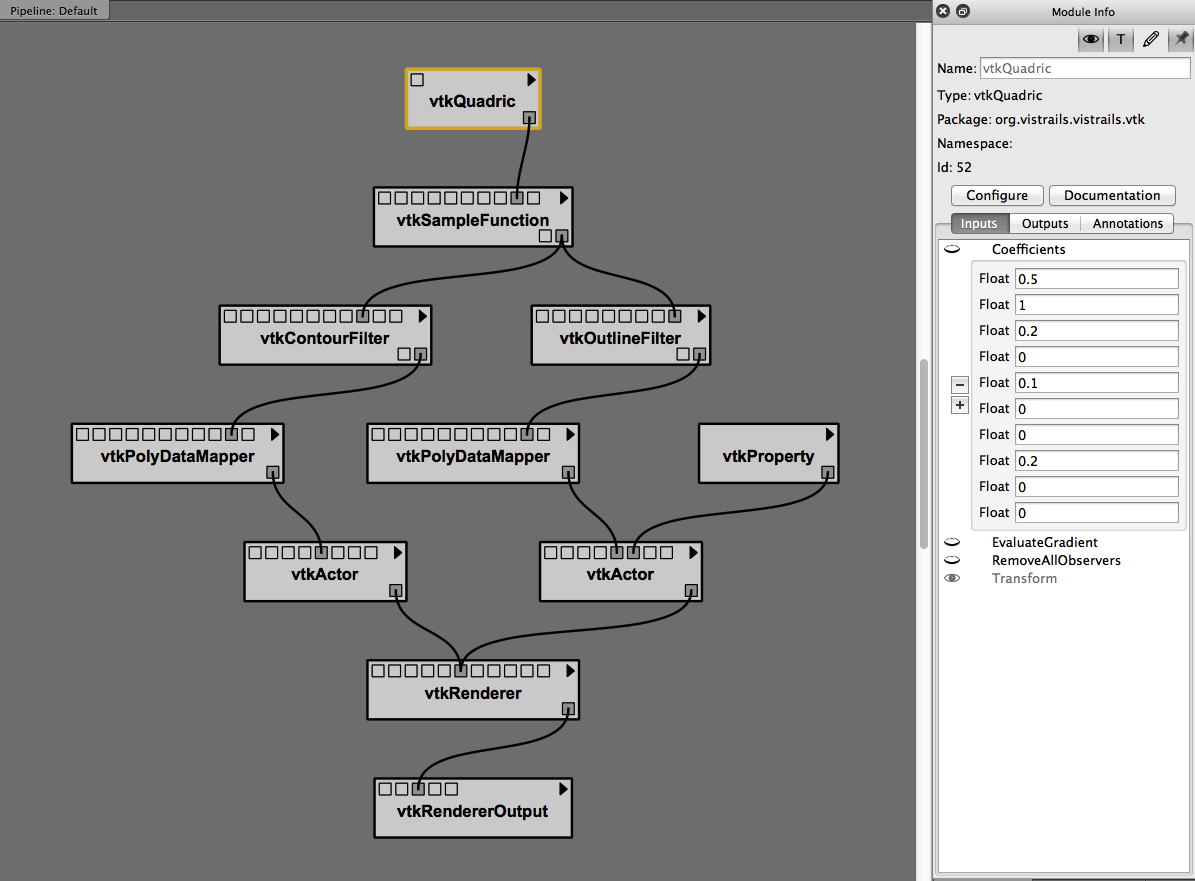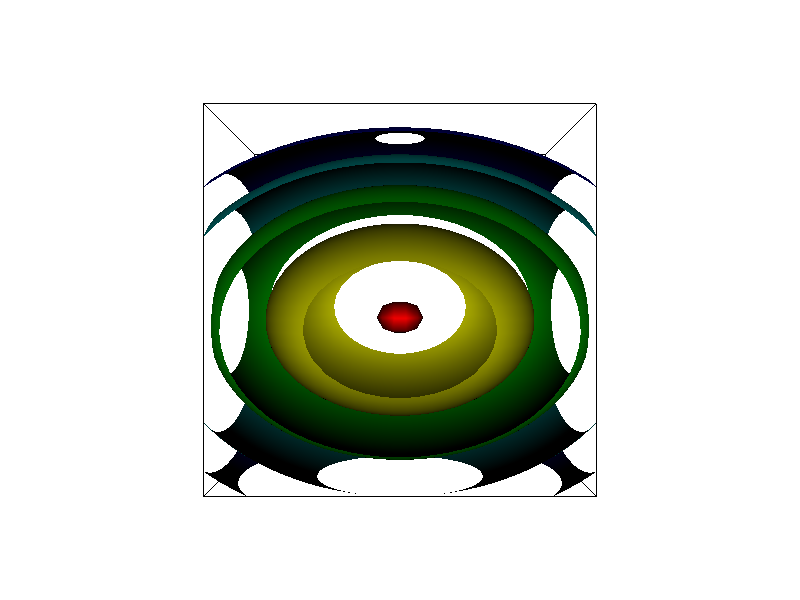User:Tohline/vtk/Quadric
Generating Spheroids, Ellipsoids, and Quadrics

|
|---|
| | Tiled Menu | Tables of Content | Banner Video | Tohline Home Page | |
Getting Started
Here we explore the vtkQuadric method, which has been used to generate Figure 5-2 (§5.1, p. 77) of the VTK User's Guide, authored and published by Kitware, Inc., in an effort to learn how to draw two-dimensional spheroidal structures, three-dimensional ellipsoidal structures, and other analytically specifiable configurations.
1. Inside VisTrails, open, then execute "VisQuad.vt" without making any changes to the default pipeline or to any module parameters:
- Follow this directory path: VisTrails/examples/vtk_examples/VisualizationAlgorighms/VisQuad.vt
- The default workflow pipeline is shown in the top panel of the following figure. Upon execution, the default composite image that pops up in the VisTrails spreadsheet window is shown in the bottom panel.
| Figure 1: Default |
|---|
Various Modules
vtkQuadric
In the workflow image displayed above, the vtkQuadric module has been highlighted, so the inset window to the right of the workflow pipeline displays the values of the 10 separate model coefficients that have been used to generate the default "Quadric" configuration. Presumably, these values correspond, respectively, to coefficients <math>~a0, a1, a2, a3 \ldots a9</math> as they appear in the quadric function definition as provided in the default module documentation and as reprinted here:
| vtkQuadric Module Documentation |
|---|
|
vtkQuadric - evaluate implicit quadric function Superclass: vtkImplicitFunction vtkQuadric evaluates the quadric function F(x,y,z) = a0*x^2 + a1*y^2 + a2*z^2 + a3*x*y + a4*y*z + a5*x*z + a6*x + a7*y + a8*z + a9. vtkQuadric is a concrete implementation of vtkImplicitFunction. |
We conclude that the default image displayed above illustrates geometric properties of an underlying scalar field that has been generated from the function,
|
<math>~F_0(x,y,z)</math> |
<math>~=</math> |
<math>~\frac{x^2}{2} + y^2 + \frac{z^2}{5} + \frac{yz}{10} + \frac{y}{5}\, .</math> |
vtkSampleFunction
As implemented in this example visualization, this module assigns default values and behavior to all methods except one:
- SampleDimensions is specified by the three integers (30, 30, 30); this is presumably the number of (uniformly sized) grid cells in each of the three coordinate directions — respectively, (x, y, z) — that will be assigned values of the function, <math>~F_0(x, y, z)</math>.
While initially deciphering the behavior of this entire workflow, I wondered how the edges of the (black) bounding box were specified. Simultaneously, I wondered over what range of values of x, y, and z the grid resolution of (30, 30, 30) was being stretched. The answer to both of these questions is the same. The function is sampled over the range of coordinate values — and the (black) bounding box is drawn at the edges of this sampled region — as specified by the vtkSampleFunction method, ModelBounds.
- By experimentation, I discovered that the default coordinate values assigned to Modelbounds are, for x, y, and z, respectively, (-1.0, 1.0), (-1.0, 1.0), and (-1.0, 1.0). By assigning, instead, values of (0.0, 1.0), (0.0, 1.0), and (0.0, 1.0), precisely one octant of the original configuration is displayed.
vtkContourFilter
As is explained at the top of p. 78 of the VTK User's Guide, five different contours — that is, five different surfaces differentiated from one another by color — have been drawn. The specific set of surfaces has been specified via the "GenerateValues" method inside the vtkContourFilter module. Clicking on (i.e., highlighting) the vtkContourFilter module in the VisTrails workflow reveals that three numbers have been specified:
- Two floating-point numbers identify the "scalar range" — in the default case, the specified range is <math>0.0 \rightarrow 1.2</math>;
- The single integer identifies the "number of contours to be generated in the range (end values inclusive).
We conclude that the five separately colored "surfaces" correspond to contours for which the function, <math>~F_0(x,y,z)</math>, is constant and has the following values:
| Contour Color: | red | yellow | green | light blue | dark blue |
|---|---|---|---|---|---|
| Associated Scalar Value: | 0.0 | 0.3 | 0.6 | 0.9 | 1.2 |
vtkPolyDataMapper
This default workflow contains two independent instances of the vtkPolyDataMapper module. The instance on the left plays a role in mapping the nested color contours to the image screen (that is, to the spreadsheet window) while the instance on the right plays a role in mapping the bounding box to the screen.
- vtkPolyDataMapper (left) — notice that a ScalarRange of (0.0, 1.2) has been explicitly assigned, which is exactly the same "scalar range" that has been explicitly assigned inside the vtkContourFilter module. This means that the default color table, which spans from red to dark blue, should be stretched to cover the entire range of scalar values that is being probed. The colors of the five distinct contours can be changed by specifying a different ScalarRange inside this instance of vtkPolyDataMapper (left). For example, setting ScalarRange = (0.0, 0.6) will squeeze the full dynamic range of the color table into a narrower range of scalar values; the first three contours — <math>~F_0</math> = 0.0, 0.3, and 0.6 — will be colored red, green, and dark blue, while the last two contours — <math>~F_0</math> = 0.9 and 1.2 — will be pegged to the color dark blue because they are outside of the new identified range.
- vtkPolyDataMapper (right) — notice that default values and behaviors are accepted throughout.
We should point out that, in this default workflow, the color of the bounding box is set (to black) by the Color method inside of the vtkProperty module; this can be readily changed to generate a bounding box whose edges are a different color, for example, red.

